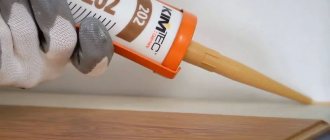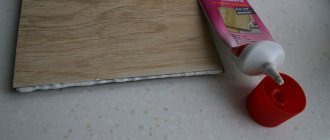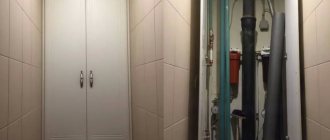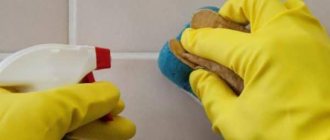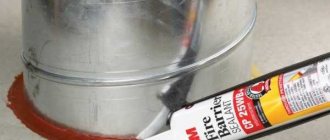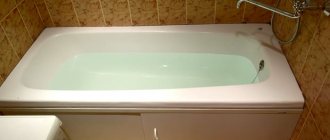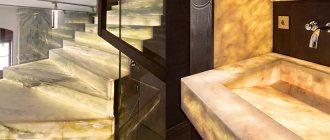When performing finishing work, there is often a need to seal joints, seams, and cracks. Most often in such situations, a very popular acrylic sealant is used. It helps protect certain areas from temperature changes and the harmful effects of moisture. This product adheres well to many building materials, lasts a long time, and is considered safe for human health. Before using this product, it is important to become familiar with its advantages and disadvantages.
Acrylic sealant is designed for filling cracks and sealing various seams Source i.ytimg.com
Characteristics of acrylic sealant
A modern product containing acrylic is intended for moisture insulation and sealing of various joints. It is perfect for inexperienced users: it is easy to use, does not harden for a long time, thanks to which the position of the seam can be corrected. This composition is quite elastic, easily adapts to slight vibration, and after drying it can be plastered or painted.
Acrylic sealants are used to fill gaps and cracks: you just need to pour them inside and wait until dry. The material retains its characteristics indoors and is not afraid of temperature fluctuations or changes in humidity. Street conditions are less favorable for such compositions: in severe frost they (in the absence of special ingredients) become hard and sometimes crack.
Most acrylic sealants are waterproof, but they lose their properties when constantly exposed to moisture Source mirsmazok.ru
Technical specifications
The quality of acrylic sealants is assessed by an important indicator: elongation at the maximum possible stress. When a product is stretched while simultaneously subjected to excessive stress (more than the maximum permissible value), it will begin to become irreversibly deformed. As the number increases, the elasticity of the acrylate sealant increases. High-quality compounds have an indicator of 10% and above. When the mark on the package is 11%, they are already allowed to be used outdoors. Additionally, it is worth noting the following characteristics of acrylic-based sealants:
- permissible seam width is 0.6-5 cm, optimal thickness is correspondingly half that;
- operating temperature – from -20°С to +70°С;
- film formation time – 15 minutes;
- the period of adhesion of acrylic sealant to the base is no more than one hour;
- Drying time – 24 hours at humidity 50%, temperature 23°C;
- frost resistance (for a separate group) – more than five freeze-thaw cycles;
- break rate – 500%.
After curing, the acrylic sealant acquires optimal strength and resistance to deformation loads Source i.ytimg.com
Varieties
Depending on the characteristics of operation and chemical composition, modern acrylic sealants are divided into groups.
Frost-resistant
The products are resistant to precipitation, aggressive external influences, and negative temperatures. They have significant elasticity and retain their integrity in the event of freezing. Most products are recommended to be used at -20°C and above, but there are more frost-resistant sealing mixtures. With their help, it is possible to process seams between logs and concrete slabs.
Frost-resistant acrylic sealant can be used for external repair and construction work in regions with very cold winters Source kraska.guru
Moisture resistant
They differ in their composite composition (silicon and rubber are added) and often contain other components that significantly improve the quality of the product. They are well suited for different purposes in rooms with high humidity (bathroom, kitchen). Compared to ordinary acrylic joint sealants, moisture-resistant products are better able to withstand temperature fluctuations and have fairly high adhesion to other building materials.
Moisture-resistant acrylic sealant is not intended for use in conditions of constant contact with water Source kraska.guru
Non-moisture resistant
Suitable only for interior work in conditions of normal or low humidity. They are often used when performing minor repairs, gluing baguettes and baseboards. Such products are recommended for use on concrete, brick, and wooden surfaces.
Non-moisture-resistant acrylic sealant is intended for rooms with normal humidity, is highly durable and resistant to fading Source elnik.com.ua
Brief conclusion
From the above, we see: you shouldn’t pay attention to the beautiful names of acrylic sealants that marketers come up with, but you should pay attention to its technical characteristics ! The narrower the scope of application (highly specialized), the more expensive the sealant is on the market, although the sealant may be no different from ordinary household sealant. The purpose of such names is not to help with choice, but to earn more.
The price of acrylic sealant, compared to other sealants, is one and a half times cheaper or more, but this does not indicate poor quality of the material, but only that more time is now being devoted to the development of acrylic sealants using new raw materials, formulations and new technologies. In addition, the demand for acrylic sealants is constantly growing.
Color variety
You can often see white or colorless acrylic sealants in hardware stores. They are extremely popular among users because they fit perfectly with various plumbing fixtures and tiles. It is important to note that transparent compounds are hardly noticeable on treated surfaces. If you want to choose a sealing material that matches the color of the base, you need to buy a pigmented product of the desired color. There are also products in wood shades: oak, walnut, cherry, wenge and others.
A wide range of colors of acrylic sealants for wood makes it easy to choose the material that matches the color when processing any base. Source st3.stblizko.ru
Advantages and disadvantages of acrylic sealants
Using acrylic in repair work has a number of advantages. The main advantages of products containing it are:
- affordable price;
- wide choose;
- easy to use;
- the ability to correct defects;
- environmental friendliness;
- fire safety;
- do not turn yellow after a while;
- high adhesion to other building materials;
- Painting, puttying, mechanical processing of the seam is allowed;
- good vapor permeability;
- UV resistance;
- the ability to update damaged areas.
The main disadvantage of acrylic sealant is its intolerance to frequent contact with water. Being in a very humid environment, it gradually dissolves, and the seam accordingly deteriorates. Moisture-resistant materials can come into contact with moisture only after final drying. But with constant exposure to liquid, they lose their characteristics over time.
Vapor permeability is an important characteristic of acrylic sealant, which does not allow moisture to accumulate indoors Source omega-gc.ru
Silicone based products
Sealant Ravak Professional (white) X01200
Professionals consider this insulating material to be one of the best among all that are available on the domestic market today. They recommend using it when installing bathtubs, shower trays, vanities, sinks, shower enclosures and traditional shower enclosures. Ordinary users extremely rarely give preference to this sealant for one simple reason - it is very expensive.
More: Top 10 laser levels
According to users, the product is characterized by ideal adhesive properties and tightly fills the seams, minimizing any chance of leakage. Over time, it does not begin to wash out, while retaining its original color. The composition also contains antifungal additives that prevent the formation of mold. This sealant dries in the shortest possible time - it begins to harden just an hour after application. Nevertheless, experts advise waiting a full day before using plumbing fixtures for the first time. On sale you can find a white or transparent composition.
Advantages:
- Eliminates even the slightest possibility of leaks;
- Excellent antifungal characteristics;
- Over time, it does not change color and does not begin to wash out;
- Created specifically for the bathroom;
- Adheres well to materials of any nature;
- Dries quite quickly.
Flaws:
- High price.
Sealant Ravak Professional (white) X01200
Dow Corning 7091
This American-made product has long been recognized among professional plumbers as the best sealant designed for shower stalls. It is often called sealant adhesive because the waterproofing layer is very durable and reliable. The sealant layer does not wear off and does not change its color or shape over time. The product can easily withstand exposure to moisture and sunlight; seams in outdoor showers are often treated with a similar sealant, as it is not at all afraid of sudden and significant temperature changes.
Adhesion is excellent regardless of the type of base - water will not leak out. Special additives prevent the formation of mold, which makes this composition even more attractive to most users.
Advantages:
- Perfectly withstands high humidity, exposure to water, ultraviolet rays, temperature changes;
- A long period of operation, during which the sealant does not lose its useful qualities;
- Ideal for waterproofing shower cabins and cubicles.
Flaws:
- It's very expensive.
Dow Corning 7091
Kim Tec Silicon Acetate 101E
The composition is distinguished by true German quality and a very reasonable price. In particular, it is used for a variety of types of work where there is a need to protect the surface from direct contact with the aquatic environment. This sealant is well suited for bathtubs, showers and any other plumbing equipment. Adhesion is very high - the products are able to reliably and tightly contact a wide variety of materials, from wood and plastic to glass and concrete.
According to users, the products are also characterized by pronounced antifungal properties. It can withstand very high temperatures - up to 400 degrees. For this reason, this sealant is often used in baths or saunas. It takes quite a long time for the product to dry completely – this usually takes from 4 to 7 days.
Advantages:
- Maintains elasticity throughout the entire period of operation;
- An excellent combination of reasonable price and German quality;
- Long service life;
- Good antifungal qualities;
- Versatility - can be used to perform various tasks.
Flaws:
- When working with it, a persistent smell of vinegar is released, which persists for the next 10 hours.
Kim Tec Silicon Acetate 101E
Where are they used?
Acrylic sealants do not contain solvents or harmful components, which is why they are best suited for interior work. Moreover, they can be applied in a closed room. There is no need to use protective equipment.
Acrylate sealants are often used for:
- sealing joints between beams and logs;
- filling joints between concrete elements;
- sealing the places of contact of individual elements with walls;
- replacing construction adhesive (for example, when attaching skirting boards to shelves);
- gluing fillets, baguettes, as well as high-quality sealing of seams between the latter and the base.
Advice! Acrylic sealant can be used for installing ceiling tiles and filling gaps.
Acrylic sealant is often used to seal the places where individual objects come into contact with walls Source gidpokraske.ru
Features of application
The process of applying sealing material does not require special knowledge or tools. You just need to properly prepare the surface of the base: clean it from the accumulation of dirt, grease, and all kinds of old coatings, then dry it thoroughly. When you need to form a wide seam, you must purchase a sealant (for example, polyethylene cord) in advance. It will minimize the thermal conductivity of the connection, make it more reliable, and also significantly reduce material consumption (up to 70%).
Acrylic sealant can be applied without using gloves (it is harmless to the skin). However, it cannot be diluted with any liquid (including solvents). This will significantly reduce the quality characteristics of the mixture and lead to cracking of the seam.
You can apply the composition with a special gun: it is easy to insert cartridges and tubes into it. It is better to spread the sealing agent from a bucket with a narrow spatula; from a tube, squeeze it out in portions onto the required area.
After applying the acrylic sealant, it can be given the desired shape within another quarter of an hour. After the specified time, a polymer film begins to form, so repairing the seam will be difficult and impractical. The hardening of such material continues for a day; at a low temperature, the process is delayed for several more hours.
Technology of use
In addition to sealant, when sealing cracks you will need:
- A special gun that makes it convenient to squeeze the solution out of the tube.
- Masking tape. Most sealants can be easily removed with water until they have hardened. But it’s worth additionally protecting the frames and slopes from getting hit.
- Sponge and container with water.
Preliminary preparation consists of cleaning the surface and crevices from dirt. Dust, grease, remnants of protective film - all this will reduce the adhesion of the material. When wet cleaning, time is allowed for the surface to dry. Masking tape is applied along the contour of the cracks to be sealed.
Important! Plastic elements - window frames, sandwich panels, window sills - cannot be degreased with acetone-based solvents. There will be stains and stains on them.
Sealant application technology:
- Holding the syringe with the composition at an acute angle, carefully fill the gaps. At the same time, the nose of the syringe smoothes the seam.
USEFUL INFORMATION: Window profiles: types
- We wet our finger in water and form the seam completely, making sure that the sealant completely fills the space between the frame and the slope. You can easily clean your finger from the sealant with a simple napkin.
- Use a wet sponge to carefully remove excess. At the same time, we must not damage the integrity of the seam, so we wash and wet the sponge more often.
- We seal the window in parts to prevent the sealant from hardening before the seam is formed. First, we perform operations on one section of the window, and after completing the entire cycle of work, we move on to the next one. This way the seal will be of high quality.
- We pay special attention to the cleaning stage: forgotten drops of solution will darken over time and spoil the appearance of the window opening, and removing them in a frozen state is problematic.
Note! The technology for applying liquid plastic is different. The composition is squeezed out in an even strip; it cannot be smeared or rubbed into the seam.
Consumption of funds
The required amount of acrylic sealant depends on the size of the future seam. In order to calculate it, you should multiply the depth and width of the gap. The result will be an approximate volume of material: it will show the required weight of the product (in grams) per 1 meter.
In the case where the joint is triangular in shape (instead of the usual rectangular), the final value should be divided by two. As practice shows, for 10 m of medium-thick seams, 250 g of sealing compound is sufficient.
Removing traces
It often happens that acrylic sealant accidentally gets on different surfaces. If it has not yet hardened, it is easy to remove. To do this, you need to thoroughly wash the base with soapy water.
Removing hardened material requires the use of a razor or sharp knife. Cut off the product layer by layer and very carefully so as not to damage the affected object. Residues should be rubbed off with fine sandpaper, steel wool or pumice. From delicate surfaces, such a composition is carefully removed with a wooden scraper. After finishing work, wash the cleaned base with a gentle detergent and then dry it.
Fresh traces of acrylic sealant can be easily washed off with water or a gentle detergent Source kraska.guru
Sealing a Bathtub: 3 Easy Steps
To create an even and high-quality seam that will prevent water leaks and high humidity, use the instructions for working with the sealant:
- Make sure the sealing area is clean and free of dust and old sealant residue. If necessary, clean the surface, degrease it, and wipe it dry with a simple cloth.
- Select a sealant that suits the environmental conditions. If you are looking for a bathroom sealant, it should be a water-repellent formula. Some manufacturers offer sealants with additional protection against mold and mildew. Since a humid environment is favorable for the spread of germs, this option will help you get rid of unwanted unsanitary conditions. The easiest way to apply sealant is with a construction gun. Adjust the foam flow using the lever to create an even, single layer seam. Remove excess from the surface. If the gap between the bathtub and the wall is wide, use a roller for convenience.
- Smooth the solution to avoid unevenness. Prepare a solution at home from detergent and water in a 1:1 ratio. Dip your finger into the resulting liquid and smooth out the seam. As a result, you should have a perfectly even strip.
How to choose a sealant
Usually in stores you can find universal sealing agents, as well as separately for windows and doors. In reality, the difference between them is minimal.
When processing smooth surfaces, it is important to additionally take the following measures: apply a special primer with abrasive particles to the base or walk over it with sandpaper. As a rule, such preparatory procedures are applied to various types of plastic.
Acrylic sealant is suitable for application to window structures: after final drying, it can be coated with suitable paint.
When purchasing a sealant for the kitchen or bathroom, it is necessary to take into account its resistance to moisture and the presence of fungicides in the composition.
When sealing joints in aquariums and shower stalls, it is recommended to use a sealant containing silicone.
In order to seal stoves, fireplaces, and other heating structures, it is better to purchase silicone or silicate compounds that are resistant to the influence of excessively high temperatures.
Polyurethane
Sealants are made from viscous polymer components of synthetic origin. Polyurethane types are designed for use under extreme conditions and under heavy loads. To improve characteristics, various additives are added to the composition.
Features of the product
Polyurethane varieties are considered one of the best sealants for the bathroom. The substances combine the functions of adhesive and insulating agents. Elastic properties reach 99%, which is higher than that of silicone options. Under any mechanical stress, corners and seams (old, new) will remain sealed. Sanitary models are often used to seal water pipe outlets and for gluing all types of surfaces.
Polyurethane sealants are resistant to vibration and corrosion. When used in damp conditions, the insulating qualities increase. The characteristics of the substance resemble polyurethane foam. After application to the surface, polymerization processes are activated, as a result of which the product dries quickly.
Elastic look for the bathroom Source decorstudia.com.ua
Differences between acrylate sealant and silicone
Sealing agents containing acrylic or silicone vary in properties and methods of use:
- After final hardening, acrylic seams can be painted in various colors with any water-based acrylate or latex paint. If necessary, treated areas can be easily restored and locally updated. The coloring composition does not adhere well to the silicone base.
- Acrylic sealant can be processed using mechanical methods: drilling, grinding. Silicone in the event of such an impact can completely separate, damaging the connection.
- The elasticity of acrylic is lower than that of silicone. Materials based on the latter are more plastic, give minimal shrinkage, and stretch well (without damage).
- Acrylic sealant is vapor-permeable, silicone is airtight. Therefore, the first does not have a negative effect on the microclimate inside the room.
- The moisture resistance of acrylic is significantly lower than silicone, a completely waterproof material that resembles rubber in its properties. Acrylate products are water-based, so they are subject to gradual dissolution.
- Acrylates are characterized by significant adhesion to porous building materials and are excellent for wooden and concrete bases. On the eve of sealing, smooth surfaces must be sanded to improve the quality of adhesion.
- Regular acrylic sealant costs less than silicone. Typically the difference is about 40%.
- The color range of acrylate products is significantly richer. If necessary, it is possible to select a suitable material of any color, including various types of wood. Silicone compounds are produced only in white, grayish, black, and red colors.
- Silicone lasts up to twenty years. Acrylic begins to lose its properties earlier; after a while it can dry out.
- Acrylates are environmentally friendly: safe for human health and do not harm nature. Silicone sealants made with acids emit an unpleasant odor, which limits their use.
Acrylic joint sealant is best suited for application indoors where the humidity level does not exceed normal values, provided there is no contact with liquid. This product is considered indispensable when the seam is planned to be painted. It is often used to eliminate cracks in window or door structures and seal plumbing fixtures. Silicone products are suitable for external use, bathrooms, sealing the walls of aquariums, and other items in contact with water. However, they cannot be used for processing concrete, stones, and metal bases.
How to cover cracks in the wall? All methods and options
Before deciding how to cover the cracks in the wall, you need to decide on all the conditions involved. First of all, with the material from which the affected surface is made. The rules for sealing defects in a brick, concrete or plastered wall are different. The second thing that influences the order of work carried out is the size of the crack formed, and, first of all, its depth. It is also important where it appeared, outside or inside the room. It would also be a good idea to find out what caused the hole. If it was caused by shrinkage of the building, this can be considered a natural process and the consequences can be eliminated with a light heart. If a crack has started due to deformation of the structure, repairing it will not give long-term results: the defect will appear again.
In the case of multi-storey buildings, such alarming symptoms require calling a commission from the DEZ, drawing up a protocol and immediate action on their part, especially if the crack is coming from the outside and has already affected 2 floors. For internal defects, finding out the reasons is important because cracking of the plaster can be caused by poor quality of work. In this case, close it up, don’t close it up - new ones will appear. It may need to be completely removed and re-plastered.
Cracks in plaster
They are subject to repair only if the cracks have not reached the base and are few in number. When they are deep and spread over the entire surface, this means that too thick a layer was applied, possibly with a violation of the mixing technology. Here you can’t get by with half measures; you’ll have to chip away at the entire layer. If the situation is not catastrophic, you will need a brush, a brush, a solution and a spatula.
The damaged area is cleaned with sandpaper, including the coating, if it was applied (a spatula will be used here).
Dust is removed with a brush; the gap and its surroundings are washed and dried.
A solution is being prepared - more liquid than that used for plastering. In exterior work, it must be based on cement; in interior work, gypsum can also be used.
The gap is filled with a spatula, leveled, and after drying it is rubbed with sandpaper.
If there is a whole network of small cracks, the area of wall plaster needs to be strengthened. Here, in addition to the specified tools and materials, a primer and a sickle mesh should be included.
The initial surface preparation work remains the same.
The cleared area is treated with deep penetration soil.
A putty mesh is glued over the entire area. It should extend beyond the boundaries of the damaged area by 3-5 cm in all directions.
The restored surface is covered with a thin layer of finishing putty and, after drying, sanded.
All these measures give results only if the cracks have not begun to expand and spread to the rest of the wall.
Restoring a brick wall
You can also seal cracks in such a surface with masonry mortar. However, such patches are not very reliable. Builders recommend using acrylic sealant to achieve long-term results. It has a high degree of elasticity even in a set state, and it will not crumble even with a sharp change in external conditions.
The gap is widened - it is cleaned in depth and width until the tool rests on a strong material that has not begun to collapse.
The area to be sealed is treated with primer developed specifically for sealant.
The gap is filled with the compound using a construction gun.
When restoring cracks in brick, you should never use silicone sealants: neither paint nor plaster will stick to them, and the repaired crack will look like a scar on a flat surface.
Similarly, you can seal a crack in concrete, only after filling it with sealant, it is recommended to lay a serpyanka on top.
